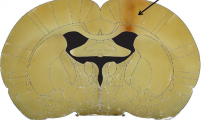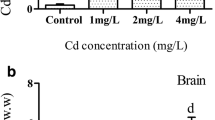Abstract
Cadmium is a neurotoxic heavy metal and is considered endocrine disruptor. In this work, we investigate the effects of cadmium on the 24 h changes of aspartate, glutamate, and glutamine content in the pituitary. Adult male Sprague–Dawley rats were treated with 25 or 50 mg/l of cadmium chloride (CdCl2) in the drinking water for 30 days. Metal exposure with the lowest dose induced the disappearance of the nocturnal peak of anterior pituitary amino acid content, and the appearance of a peak of glutamine concentration during the resting phase of the photoperiod. After exposure to 50 mg/l of CdCl2, the peaks of anterior pituitary amino acid content at 12:00 and 00:00 h disappeared, and two minimal values at these same hours and a peak at 08:00 h appeared. In the posterior pituitary, cadmium treatment with the lowest dose induced the appearance of a peak of aspartate and glutamate concentration at 12:00 h, and the disappearance of the peak of glutamine content at 16:00 h. After exposure to 50 mg/l of CdCl2 aspartate and glutamate daily pattern presented two maximal values between 00:00 and 04:00 h, and the metal abolished glutamine daily pattern. These results suggest that cadmium disrupted aspartate, glutamate, and glutamine daily pattern in the pituitary.






Similar content being viewed by others
References
Antonio MT, Benito MJ, Leret ML, Corpas I (1998) Gestational administration of cadmium alters the neurotransmitter levels in newborn rat brains. J Appl Toxicol 18:83–88. doi:10.1002/(SICI)1099-1263(199803/04)18:2<83::AID-JAT480>3.0.CO;2-1
Bradford MM (1976) A rapid and sensitive method for the quantitation of microgram quantities of protein utilizing the principle of protein–dye binding. Anal Biochem 72:248–254
Calderoni AM, Oliveros L, Jahn G, Anton R, Luco J, Gimenez MS (2005) Alterations in the lipid content of pituitary gland and serum prolactin and growth hormone in cadmium treated rats. Biometals 18:213–220. doi:10.1007/s10534-005-0581-4
Cano P, Cardinali DP, Chacon F, Castrillón PO, Reyes Toso CA, Esquifino AI (2001) Age-dependent changes in 24-hour rhythms of catecholamine content and turnover in hypothalamus, corpus striatum and pituitary gland of rats injected with Freund’s adjuvant. BMC Physiol 1:14
Cano P, Poliandri AH, Jiménez V, Cardinali DP, Esquifino AI (2007) Cadmium-induced changes in Per 1 and Per 2 gene expression in rat hypothalamus and anterior pituitary: effect of melatonin. Toxicol Lett 172:131–136. doi:10.1016/j.toxlet.2007.05.011
Caride A, Fernández-Pérez B, Cabaleiro T, Esquifino AI, Lafuente A (2009) Cadmium exposure disrupts GABA and taurine regulation of prolactin secretion in adult male rats. Toxicol Lett 185:175–179. doi:10.1016/j.toxlet.2008.12.016
Caruso C, Bottino MC, Pampillo M, Pisera D, Jaita G, Duvilanski B, Seilicovich A, Lasaga M (2004) Glutamate induces apoptosis in anterior pituitary cells through group II metabotropic glutamate receptor activation. Endocrinology 145:4677–4684. doi:10.1210/en.2004-0550
Castañeda TR, de Prado BM, Prieto D, Mora F (2004) Circadian rhythms of dopamine, glutamate and GABA in the striatum and nucleus accumbens of the awake rat: modulation by light. J Pineal Res 36:177–185. doi:10.1046/j.1600-079X.2003.00114
Cory-Slechta DA, Weiss B (1981) Aversiveness of cadmium in solution. Trends Neurosci 19:417–422
Cuadrado C, Kumpulainen J, Moreiras O (1995) Lead, cadmium and mercury contents in average Spanish market basket diets from Galicia, Valencia, Andalucía and Madrid. Food Addit Contam 12:107–118
Duvilanski BH, Selgas L, García-Bonacho M, Esquifino AI (1998) Daily variations of amino acid concentration in mediobasal hypothalamus, in rats injected with Freund’s adjuvant. Effect of cyclosporine. J Neuroimmunol 87:189–196. doi:10.1016/S0165-5728(98)00108-8
Esquifino AI, Cano P, Chacon F, Reyes Toso CF, Cardinali DP (2002) Effect of aging on 24-hour changes in dopamine and serotonin turnover and amino acid and somatostatin contents of rat corpus striatum. Neurosignals 11:336–344. doi:10.1159/000068258
Esquifino AI, Cano P, Jimenez V, Reyes Toso CF, Cardinali DP (2004) Changes of prolactin regulatory mechanisms in aging: 24-h rhythms of serum prolactin and median eminence and adenohypophysial concentration of dopamine, serotonin (gamma-aminobutyric acid, taurine and somatostatin in young and aged rats. Exp Gerontol 39:45–52. doi:10.1016/j.exger.2003.08.004
Fernández-Pérez B (2008) Efectos tóxicos del cadmio en la regulación aminoacidérgica de la secreción hipofisaria. Dissertation, University of Vigo
Flora SJ, Tandon SK (1987) Effect of combined exposure to cadmium and ethanol on regional brain biogenic amine levels in the rat. Biochem Int 15:863–871
Fox MR (1983) Cadmium bioavailability. Fed Proc 42:1726–1729
Furuchi T, Homma H (2005) Free d-aspartate in mammals. Biol Pharm Bull 28:1566–1570 (review)
Gotti C, Cabrini D, Sher E, Clementi F (1987) Effects of long-term in vitro exposure to aluminum, cadmium or lead on differentiation and cholinergic receptor expression in a human neuroblastoma cell line. Cell Biol Toxicol 3:431–440
Gupta A, Gupta A, Murthy RC, Thakur SR, Dubey MP, Chandra SV (1990) Comparative neurotoxicity of cadmium in growing and adult rats after repeated administration. Biochem Int 21:97–105
Herzog ED (2007) Neurons and networks in daily rhythms. Nat Rev Neurosci 8:790–802. doi:10.1016/j.addr.2007.01.001 Review
Hrabovszky E, Deli L, Turi GF, Kalló I, Liposits Z (2007) Glutamatergic innervation of the hypothalamic median eminence and posterior pituitary of the rat. Neuroscience 144:1383–1392. doi:10.1016/j.neuroscience.2006.10.053
Ikeda M (2004) Calcium dynamics and circadian rhythms in suprachiasmatic nucleus neurons. Neuroscientist 10:315–324. doi:10.1177/10738584031262149 Review
Jones MM, Cherian MG (1990) The search for chelate antagonists for chronic cadmium intoxication. Toxicology 62:1–25 Review
Kalsbeek A, Verhagen LA, Schalij I, Foppen E, Saboureau M, Bothorel B, Buijs RM, Pévet P (2008) Opposite actions of hypothalamic vasopressin on circadian corticosterone rhythm in nocturnal versus diurnal species. Eur J Neurosci 27:818–827. doi:10.1111/j.1460-9568.2008.06057
Lafuente A, Márquez N, Pérez-Lorenzo M, Pazo D, Esquifino AI (2001a) Cadmium effects on hypothalamic–pituitary–testicular axis in male rats. Exp Biol Med (Maywood) 226:605–611
Lafuente A, Fenández-Rey E, Seara R, Pérez-Lorenzo M, Esquifino AI (2001b) Alternate cadmium exposure differentially affects amino acid metabolism within the hypothalamus, median eminence, striatum and prefrontal cortex of male rats. Neurochem Int 39:187–192. doi:10.1016/S0197-0186(01)00029-8
Lafuente A, González-Carracedo A, Romero A, Esquifino AI (2003a) Effect of cadmium on 24-h variations in hypothalamic dopamine and serotonin metabolism in adult male rats. Exp Brain Res 149:200–206. doi:10.1007/s00221-002-1356-6
Lafuente A, Cano P, Esquifino A (2003b) Are cadmium effects on plasma gonadotropins, prolactin, ACTH, GH and TSH levels, dose-dependent? Biometals 16:243–250. doi:10.1023/A:1020658128413
Lafuente A, González-Carracedo A, Romero A, Cano P, Esquifino AI (2004) Cadmium exposure differentially modifies the circadian patterns of norepinephrine at the median eminence and plasma LH, FSH and testosterone levels. Toxicol Lett 146:175–182. doi:10.1023/A:1020658128413
Lafuente A, González-Carracedo A, Cabaleiro T, Romero A, Esquifino AI (2005a) Toxic effects of cadmium on GABA and taurine content in different brain areas of adult male rats. J Physiol Biochem 61:439–446
Lafuente A, González-Carracedo A, Romero A, Cabaleiro T, Esquifino AI (2005b) Toxic effects of cadmium on the regulatory mechanism of dopamine and serotonin on prolactin secretion in adult male rats. Toxicol Lett 155:87–96. doi:10.1016/j.toxlet.2004.08.011
Lafuente A, Cabaleiro T, Caride A, Gutiérrez A, Esquifino AI (2007) Toxic effects of methoxychlor in rat striatum: modifications in several neurotransmitters. J Physiol Biochem 63:171–177
Leret ML, Millán JA, Antonio MT (2003) Perinatal exposure to lead and cadmium affects anxiety-like behaviour. Toxicology 186:125–130. doi:10.1016/S0300-483X(02)00728-X
Liscovitch M, Czarny M, Fiucci G, Tang X (2000) Phospholipase D: molecular and cell biology of a novel gene family. Biochem J 345:401–415 Review
López E, Figueroa S, Oset-Gasque MJ, González MP (2003) Apoptosis and necrosis: two distinct events induced by cadmium in cortical neurons in culture. Br J Pharmacol 138:901–911. doi:10.1038/sj.bjp.0705111
McNulty TJ, Taylor CW (1999) Extracellular heavy-metal ions stimulate Ca2+ mobilization in hepatocytes. Biochem J 339:555–561
Minami A, Takeda A, Nishibaba D, Takefuta S, Oku N (2001) Cadmium toxicity in synaptic neurotransmission in the brain. Brain Res 894:336–339
Murphy VA (1997) Cadmium: acute and chronic neurological disorders. In: Yasui M, Strong MJ, Ota K (eds) Mineral and metal: neurotoxicology. CRC Press, Boca Raton, pp 229–240
Nelson MT (1986) Interactions of divalent cations with single calcium channels from rat brain synaptosomes. J Gen Physiol 87:201–222 Review
Nemmiche S, Chabane-Sari D, Guiraud P (2007) Role of alpha-tocopherol in cadmium-induced oxidative stress in Wistar rat’s blood, liver and brain. Chem Biol Interact 170:221–230. doi:10.1016/j.cbi.2007.08.004
Palmiter RD (1994) Regulation of metallothionein genes by heavy metals appears to be mediated by a zinc-sensitive inhibitor that interacts with a constitutively active transcription factor, MTF-1. Proc Natl Acad Sci USA 91:1219–1223
Poliandri AH, Esquifino AI, Cano P, Jiménez V, Lafuente A, Cardinali DP, Duvilanski BH (2006) In vivo protective effect of melatonin on cadmium-induced changes in redox balance and gene expression in rat hypothalamus and anterior pituitary. J Pineal Res 41:238–246. doi:10.1111/j.1600-079X.2006.00360.x
Real Ordinance 1201/2005 of October 10, 2005 sobre protección de los animales utilizados para experimentación y otros fines científicos. BOE 252, 21 October 2005, 34367-34391
Repetto M, López-Artíguez M (1995) Estado actual de la Toxicología del cadmio. In: de Santos D (ed) Toxicología Avanzada. Madrid, pp 393–418
Ronis MJ, Badger TM, Shema SJ, Roberson PK, Templer L, Ringer D, Thomas PE (1998) Endocrine mechanisms underlying the growth effects of developmental lead exposure in the rat. J Toxicol Environ Health A 54:101–120
Sam S, Frohman LA (2008) Normal physiology of hypothalamic pituitary regulation. Endocrinol Metab Clin North Am 37:1–22. doi:10.1016/j.ecl.2007.10.007 Review
Schantz SL, Widholm JJ (2001) Cognitive effects of endocrine-disrupting chemicals in animals. Environ Health Perspect 109:1197–1206 Review
The Commission of the European Communities (1986) Council Directive (1986/609/EC) of November 24, 1986 on the approximation of laws, regulation and administrative provisions of the Member States regarding the protection of animals used for experimental and other scientific purposes. DOCE L 358, 18 December 1986, pp 1–28
The Commission of the European Communities (2001) European Community Regulation (2001/466/EC) of March 8, 2001 setting maximum levels for certain contaminants in foodstuffs. DOCE L 77, 16 March 2001, pp 1–27
Wang S, Hu P, Wang HL, Wang M, Chen JT, Tang JL, Ruan DY (2008) Effects of Cd(2+) on AMPA receptor-mediated synaptic transmission in rat hippocampal CA1 area. Toxicol Lett 176:215–222. doi:10.1016/j.toxlet.2007.11.008
World Health Organization (2000) Evaluation of certain food additives and contaminants. In: 55th Report of the Joint FAO/WHO Expert Committee on Food Additives. Geneva, Switzerland
Yang XF, Zhu W, Wei Q, Lin ZN (2005) Effect on apoptosis of anterior pituitary induced by cadmium chloride and its relations with p38 MAPK&ERK1/2 passway. Wei Sheng Yan Jiu 34:681–684
Acknowledgments
This work was supported by a grant from the Xunta de Galicia (PGIDT99PXI38301B).
Author information
Authors and Affiliations
Corresponding author
Rights and permissions
About this article
Cite this article
Caride, A., Fernández Pérez, B., Cabaleiro, T. et al. Daily pattern of pituitary glutamine, glutamate, and aspartate content disrupted by cadmium exposure. Amino Acids 38, 1165–1172 (2010). https://doi.org/10.1007/s00726-009-0327-7
Received:
Accepted:
Published:
Issue Date:
DOI: https://doi.org/10.1007/s00726-009-0327-7




